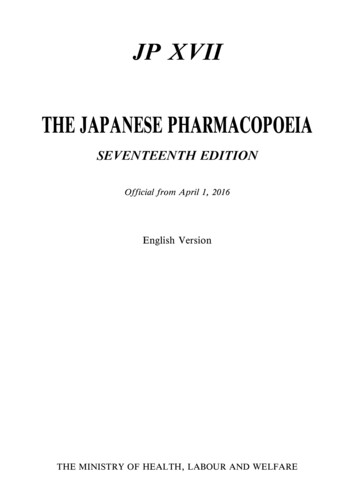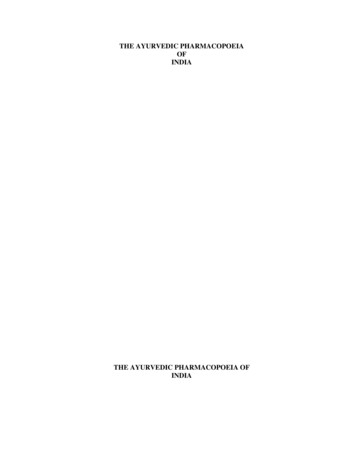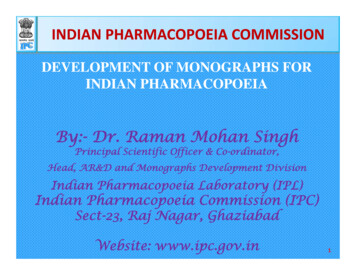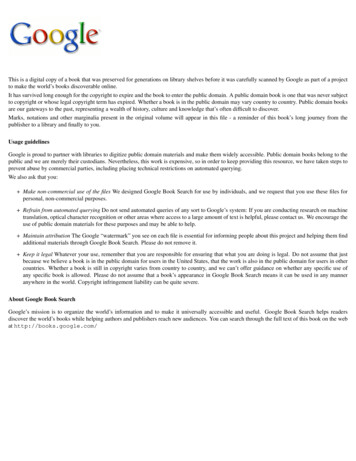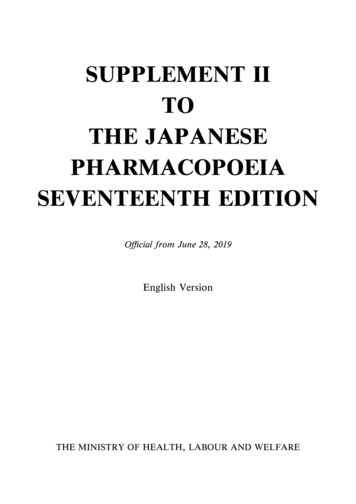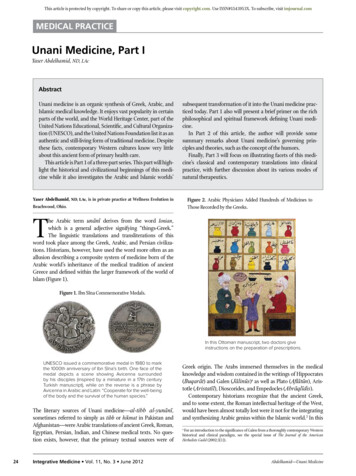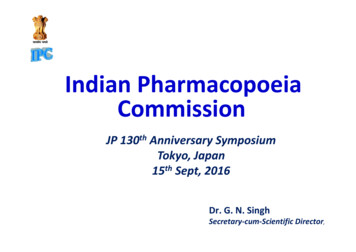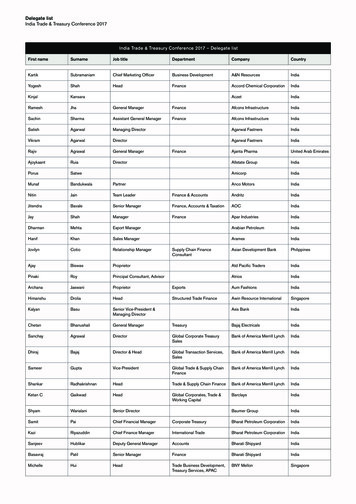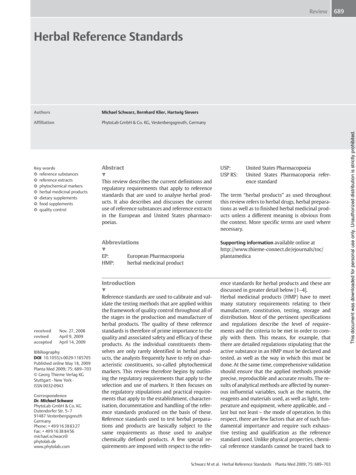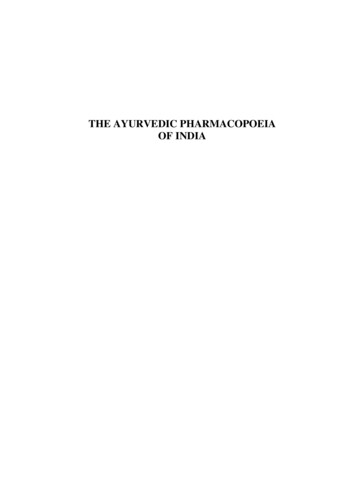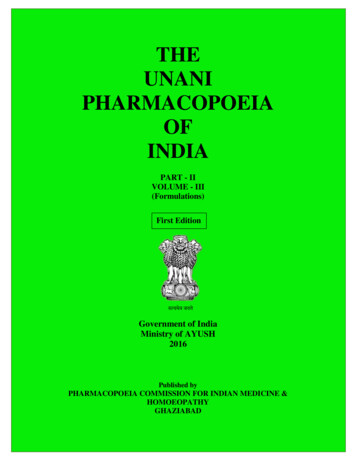
Transcription
THEUNANIPHARMACOPOEIAOFINDIAPART - IIVOLUME - III(Formulations)First Editionसत्यमेव जयतेGovernment of IndiaMinistry of AYUSH2016Published byPHARMACOPOEIA COMMISSION FOR INDIAN MEDICINE &HOMOEOPATHYGHAZIABAD
THEUNANIPHARMACOPOEIAOFINDIAPART - IIVOLUME - III(Formulations)First EditionGovernment of IndiaMinistry of AYUSH2016Published byPHARMACOPOEIA COMMISSION FOR INDIAN MEDICINE & HOMOEOPATHYGHAZIABADi
PDH.73. Pt.II.Vol.III2000-2015-(DSK-II) 2016, Pharmacopoeia Commission for Indian Medicine & HomoeopathyMinistry of AYUSH, Government of IndiaOn behalf of:Government of IndiaMinistry of AYUSH,AYUSH Bhawan, B Block,GPO Complex, INA, New Delhi - 110 023Published by:Pharmacopoeia Commission for Indian Medicine & HomoeopathyPLIM Campus, Kamla Nehru Nagar,Ghaziabad-201002 (U.P.) Indiaii
iv
vi
LEGAL NOTICESIn India there are laws dealing with drugs that are the subject of monographs which follow. Thesemonographs should be read subject to the restrictions imposed by these laws wherever they are applicable.It is expedient that enquiry be made in each case in order to ensure that the provisions of the laware being complied with.In general, the Drugs & Cosmetics Act, 1940 (subsequently amended in 1964 and 1982), theDangerous Drugs Act, 1930 and the Poisons Act, 1919 and the rules framed there under should beconsulted.Under the Drugs & Cosmetics Act, the Unani Pharmacopoeia of India (UPI), Part-II, Volumes, arethe books of standards for compound formulations included therein and the standards prescribed in theUnani Pharmacopoeia of India, Part-II, Vol. III, would be official. If considered necessary these standardscan be amended and the Pharmacopoeia Commission for Indian Medicine & Homoeopathy is authorizedto issue such amendments. Whenever such amendments are issued, the Unani Pharmacopoeia of India,Part-II, Vol. III, would be deemed to have been amended accordingly.vii
GENERAL NOTICESTitle: The title of the book is “Unani Pharmacopoeia of India, Part-II, Volume-III. Wherever theabbreviation “UPI, Pt.-II, Vol.-III is used, it may be presumed to stand for the same and the supplementsor amendments thereto.Name of the Formulation: The name given on top of each monograph is in Arabic, Persian or Urdu, asmentioned in the National Formulary of Unani Medicine (NFUM) and will be considered official. Thesenames have been arranged in English alphabetical order under each category of dosage form.Ingredients and Processes: Formulations are prepared from individual ingredients that comply with therequirements for those individual ingredients for which monographs are provided in the volumes ofUPI/Ayurvedic Pharmacopoeia of India (API), Part-I. Where water is used as an ingredient it should meetthe requirements for Purified Water covered by its monograph in the Indian Pharmacopoeia (IP).Monograph for each formulation includes the full composition together with directions for itspreparation. Such composition and directions are intended for preparation of small quantities for shortterm supply and use. When so prepared, no deviation from the stated composition and directions ispermitted. However, if such a preparation is manufactured on a large scale with the intention of sale ordistribution, deviations from the directions given are permitted, but maintaining the same ratio as statedin the monographs with the ingredients complying with the compendial requirements, and also that thefinal product meets the following criteria:(a) complies with all of the requirements stated in the monograph on compound formulations,(b) in the composition of certain formulations it has been allowed that a specified part of the plant maybe substituted by another part of the same plant. In such cases the manufacturer should mention onthe label the actual part of the plant used in the formulation.(c) wherever a formulation composition specifies a drug that is banned from commerce, this may beomitted, and the fact mentioned on the label.If a preparation is intended to be stored over a period of time, deterioration due to microbialcontamination may be inhibited by the addition to the formula of a permitted preservative. In suchcircumstances the label should state the concentration of the preservative and the appropriate storageconditions. It is implied that such a preparation will be effectively preserved according to the appropriatecriteria applied.The direction that an ingredient in a formulation must be freshly prepared indicates that it must beprepared and used within 24 hours.Monograph: Each monograph begins with a definition and introductory paragraph indicating theformulation composition, scientific names of the drugs used with their botanical parts along with a briefaccount of the method of preparation.The requirements given in the monographs are not framed to provide against all impurities,contaminants or adulterants; they provide appropriate limits only for possible impurities that may bepermitted to a certain extent. Material found to contain an impurity, contaminant or adulterant which isnot detectable by means of the prescribed tests are also to be considered as impurity should rationalconsideration require its absence.Standards: For statutory purposes, the following shall be considered official standards: Definition,Formulation composition, Identification, Physico-chemical parameters, Assay and other requirements.Added Substances: A formulation contains no added substances except when specifically permitted inthe individual monograph. Unless otherwise specified in the individual monograph, or elsewhere in theGeneral Notices, suitable substances may be added from the approved list of Drugs and Cosmetics Rules,under Rule 169 to a formulation to enhance its stability, usefulness, elegance, or to facilitate itspreparation. Such auxiliary substances shall be harmless in the amounts used, shall not exceed theviii
minimum quantity required to provide their intended effect, shall not impair the therapeutic efficacy orthe bioavailability and safety of the preparation and shall not interfere with the tests and assays prescribedfor determining compliance with the official standards. Particular care should be taken to ensure that suchsubstances are free from harmful organisms. Though the manufacturer of a formulation is given thefreedom to use an added substance, the manufacturer must guarantee the innocuousness of the addedsubstance. The manufacturer shall also be responsible to explain to the appropriate authority, if needed,regarding the purpose of the added substance(s).Description: Statement given under this title is not to be interpreted in a strict sense although they mayhelp in the evaluation of an article. However substantial departure from the requirement will not beacceptable.Capital Letters in the Text: The names of the Pharmacopoeial substances, preparations and othermaterials in the text are printed in capital initial letters, and these infer that materials of Pharmacopoeialquality have been used.Italics: Italic types are used for Scientific names of the plant drugs and microorganisms, and for somesub-headings and certain notations of the chemical names. Italic types have also been used for wordswhich refer to solvent system in TLC procedure, reagents and substances, processes covered underAppendices. Chemicals and Reagents and Substances of Processes in Appendices have also been printedin Italics.Odour and Taste: Wherever a specific odour has been observed it has been mentioned as characteristicfor that formulation, but the description as ‘odourless’ or ‘no odour’ has generally been avoided in theDescription where a substance has no odour. Where a characteristic odour is said to be present it isexamined by smelling the drug directly after opening the container. If such an odour is discernible, thecontents are rapidly transferred to an open vessel and re-examined after 15 minutes. If odour persists tobe discernible, the sample complies with the description for odour, characteristic for that formulation.The taste of a drug is examined by taking a small quantity of drug by the tip of moist glass rod andallowing it on tongue previously moistened with water. This does not apply in the case of poisonous drugs.Powder fineness: Wherever the powder of a drug is required, it shall comply with the mesh numberindicated in the Monograph.Where particle size is prescribed in a Monographs, the specified sieve number are used to fractionate aweighed representative sample from the container, each fraction weighed separately, and expressed as apercentage of the weight taken initially, to obtain compliance with the monograph.Weights and Measures: The metric system of weights and measures is employed. Weights are given inmultiples or fractions of a gram (g) or of a milligram (mg). Fluid measures are given in multiples offraction of milliliter (ml). The amount stated is approximate but the quantity actually used must beaccurately weighed and must not deviate by more than 10 per cent from the one stated.When the term “drop” is used measurement is to be made by means of a tube which delivers 20drops per gram of distilled water at 15 .Identity, Purity and Strength: Under the heading “Identification”, tests are provided as an aid toidentification and are described in the respective monographs. Microscopical characters are prescribed forthe individual ingredients where these do not exceed ten in number, added ‘in situ’. Appendix 2.1 givesdetailed procedure.Vegetable drugs used in formulations, should be duly identified and authenticated and be free frominsects, pests, fungi, microorganisms, pesticides, and other animal matter including animal excreta, bewithin the permitted and specified limits for lead, arsenic and heavy metals, and show no abnormal odour,colour, sliminess, mould or any sign of deterioration.ix
The quantitative tests like total ash, acid-insoluble ash, water-soluble ash, alcohol-solubleextractive, water-soluble extractive, moisture content, volatile oil content and assays are the parametersupon which the standards of Pharmacopoeia depend. Except for Assays, which are covered under eachmonograph, the methods of determination for others are given in Appendices, with a suitable reference tothe specific appendix.The analyst is not precluded from employing an alternate method in any instance if he is satisfiedthat the method, which he uses will give the same result as the Pharmacopoeial method described underassay. However, in the event of doubt or dispute the methods of analysis of the Pharmacopoeia are aloneauthoritative. Unless otherwise prescribed, the assays and tests are carried out at a temperature between20 and 30 .In the performance of assay or test procedures, not less than the specified number of dosage unitsshould be taken for analysis. Proportionately larger or smaller quantities than the specified weights andvolumes of assay or test substances and Reference Standards or Standard Preparations may be taken,provided the measurement is made with at least equivalent accuracy and provided that any subsequentsteps, such as dilutions, are adjusted accordingly to yield concentrations equivalent to those specified andare made in such manner as to provide at least equivalent accuracy.Where it is directed in the assay for Tablet formulation to “weigh and powder not less than” agiven number, usually 20, of the tablets, it is intended that a counted number of tablets shall be weighedand reduced to a fine powder. Likewise, where it is directed in the assay for Capsules to remove, ascompletely as possible, the contents of not less than a given number, usually 20, of the capsules, it isintended that a counted number of capsules should be carefully opened and the contents quantitativelyremoved, combined, mixed, and weighed accurately. The portion of the powdered tablets or the mixedcontents of the capsules taken for assay is representative of the whole tablets or capsules, respectively,and is, in turn, weighed accurately. The result of the assay is then related to the amount of activeingredients per tablet in the case of tablets and per capsule in the case of capsules from the weight ofcontents of each tablet/capsule.Limits for Heavy metals, Microbial load, Pesticide residues and Aflatoxin: Formulations included inthis volume are required to comply with the limits for heavy metals, microbial load, pesticide residues andAflatoxin prescribed in individual monographs and wherever limit is not given they must comply with thelimits given in Appendix. The methods for determination of these parameters are given in Appendices.Thin Layer Chromatography (TLC): Under this title, wherever given, the Rf values given in the monographsare not absolute but only indicative. The analyst may use any other solvent system and detecting reagent toestablish the identity of any particular chemical constituent reported to be present in the formulation. Howeverin case of dispute the pharmacopoeial method would prevail. Unless specified in the individual monograph allTLC have been carried out on pre-coated Silica gel GF254 aluminium plates.Reference Standards: Reference substance and standard preparation are authentic substances that havebeen verified for their suitability for use as standards for comparison in some assays, tests and TLC of theUPI.Constant Weight: The term “constant weight” when it refers to drying or ignition means that twoconsecutive weighing do not differ by more than 1.0 mg per gram of the substance taken for thedetermination, the second weighing following an additional hour of drying or further ignition.Percentage of Solutions – In defining standards, the expression per cent (%), is used, according tocircumstances, with one of the four meanings given below.Per cent w/w (percentage weight in weight) expresses the number of grams of active substance in 100grams of product.Per cent w/v (percentage weight in volume) expresses the number of grams of active substance in 100milliliters of product.x
Per cent v/v (percentage volume in volume) expresses the number of milliliters of active substance in 100milliliters of product.Per cent v/w (percentage volume in weight) expresses the number of milliliters of active substance in 100grams of product.Percentage of Alcohol: All statements of percentage of alcohol (C2H5OH) refer to percentage by volumesat 15.56 .Temperature: Unless otherwise specified all temperatures refer to centigrade (Celsius), thermometricscale and all measurement are made at 25 .Solutions: Unless otherwise specified in the individual monograph, all solutions are prepared withPurified Water.Reagents and Solutions: Reagents required for the assay and tests of the Pharmacopoeia are defined inthe Appendix showing the nature, degree of the purity and strength of solutions to be made from them.Filtration: Where it is directed to filter, without further qualification, it is intended that the liquid befiltered through suitable filter paper or equivalent device until the filtrate is clear.Soluble substances: The following table indicates the meaning of degrees of solubility:Descriptive TermsVery solubleFreely solubleSolubleSparingly solubleSlightly solubleVery slightly solublePractically insolubleRelative quantities of solventless than 1 partfrom 1 to 10 partsfrom 10 to 30 partsfrom 30 to 100 partsfrom 100 to 1000 partsfrom 1000 to 10,000 partsmore than 10,000 partsThe term ‘partly soluble’ is used to describe a mixture of which only some of the components dissolve.Therapeutic uses: Therapeutic uses of the formulations mentioned in this Pharmacopoeia are as given inthe National Formulary of Unani Medicine.Doses: The doses mentioned in each monograph are in metric system which are the approximateconversions from classical weights mentioned in Unani texts. A conversion table is appended givingclassical weights with their metric equivalents (Appendix 7). Doses mentioned in the UnaniPharmacopoeia of India (UPI) are intended merely for general guidance and represent, unless otherwisestated, the average range of quantities per dose which is generally regarded suitable by clinicians for adultsonly when administered orally. They are not to be regarded as binding upon the prescribers.The medical practitioner will exercise his own judgment and act on his own responsibility inrespect of the amount of the formulation he may prescribe or administer or on the frequency of itsadministration. If it is usual to administer a medicine by a method other than by mouth, the single dosesuitable for that method of administration is mentioned.Storage: Statement under the heading ‘Storage’ constitutes non-mandatory advice. The substances andpreparations of the Pharmacopoeia are to be stored under conditions that prevent contamination and, asfar as possible, deterioration. Precautions that should be taken in relation to the effects of the atmosphere,moisture, heat and light are indicated, where appropriate, in the individual monographs.Specific directions are given in some monographs with respect to the temperatures at whichPharmacopoeial articles should be stored, where it is considered that storage at a lower or highertemperature may produce undesirable results. The conditions are defined by the following terms.xi
Cold- Any temperature not exceeding 8 and usually between 2 and 8 . A refrigerator is cold place inwhich the temperature is maintained thermostatically between 2 and 8 .Cool- Any temperature between 8 and 25 . An article for which storage in a cool place is directed may,alternately, be stored in a refrigerator, unless otherwise specified in the individual monograph.Room temperature-The temperature prevailing in a working area.Warm- Any temperature between 30 and 40 .Excessive heat- Any temperature above 40 .Protection from freezing- Where, in addition to the risk of breaking of the container, freezing results inloss of strength or potency or in destructive alteration of the characteristics of an article the label on thecontainer bears an appropriate instruction to protect from freezing.Storage under non-specific conditions- Where no specific storage directions or limitations are given in theindividual monograph, it is to be understood that the storage conditions include protection from moisture,freezing and excessive heat.Containers: The container is the device that holds the article. The immediate container is that which is indirect contact with the article at all times. The closure is a part of the container.The container is designed so that the contents may be taken out for the indented purpose in a convenientmanner. It provides the required degree of protection to the contents from the environmental hazards.The container should not interact physically or chemically with the article placed in it so as to alter thestrength, quality or purity of the article beyond the official requirements.Prior to its being filled, the container should be clean. Special precautions and cleaning procedures maybe necessary to ensure that each container is clean and that extraneous matter is not introduced into oronto the article.Light-resistant Container- A light resistant container protects the contents from the effects of actinic lightby virtue of the specific properties of the material of which it is made. Alternatively, a clear and colourlessor a translucent container may be made light-resistant by means of an opaque (light-resistant) coveringand/or stored in a dark place: in such cases, the label on the container should bear a statement that theopaque covering or storage in dark place is needed until the contents have been used up.Well-closed Container- A well-closed container protects the contents from extraneous solids and liquidsand from loss of the article under normal conditions of handling, shipment, storage and distribution.Tightly-closed Container- A tightly-closed container protects the contents form contamination byextraneous liquids solids or vapours, from loss or deterioration of the article from effervescence,deliquescence or evaporation under normal conditions of handling, shipment, storage and distribution.Single Unit Container- A single unit container is one that is designed to hold a quantity of the drug productintended for administration as a single finished device intended for use promptly after the container isopened. The immediate container and/or outer container or protective packaging is so designed as to showevidence of any tampering with the contents.Multiple Unit Container- A multiple unit container is a container that permits withdrawals of successiveportions of the contents without changing the strength, quality or purity of the remaining portion.Tamper-evident Container- A tamper-evident container is fitted with a device or mechanism that revealsirreversibly whether the container has been opened.Labeling: In general, the labeling of drugs and pharmaceuticals is governed by the Drugs and CosmeticsAct, 1940 and Rules there under.xii
PHARMACOPOEIA COMMISSION FOR INDIAN MEDICINE & HOMOEOPATHYPharmacopoeia Commission for Indian Medicine & Homoeopathy (PCIM&H) is an autonomousorganization under Ministry of AYUSH, Govt. of India with a primary mandate to developpharmacopoeial standards for drugs/formulations used under Ayurveda, Siddha, Unani and Homoeopathicsystems of medicine. It serves as an umbrella organization for Ayurvedic Pharmacopoeia Committee(APC), Siddha Pharmacopoeia Committee (SPC), Unani Pharmacopoeia Committee (UPC) andHomoeopathic Pharmacopoeia Committee (HPC). Pharmacopoeial Laboratory for Indian Medicine(PLIM) and Homoeopathic Pharmacopoeia Laboratory (HPL) are its permanent supporting structures.The Commission was initially established as Pharmacopoeia Commission for Indian Medicine(PCIM) in the year 2010. In pursuance to the decision of Central Government, Homoeopathy wasincorporated and the Commission was renamed as Pharmacopoeia Commission for Indian Medicine &Homoeopathy (PCIM&H) on 25th June 2014. Commission has a three-tier structure of Governancecomprising of the General Body, Standing Finance Committee and Scientific Body. The Secretary,Ministry of AYUSH, Govt. of India is ex-officio Chairman of the Commission.Objectives1.Publication and revision of the Ayurvedic, Siddha, Unani and Homoeopathic Pharmacopoeia ofIndia at suitable intervals and of such addenda or supplementary compendia during the interveningperiods as may be deemed necessary; releasing the publications for public use from a date whenthey are to become official.2.Publication and revision of the Ayurvedic, Siddha and Unani Formularies of India, Homoeopathicpharmacopoeia as well as Homoeopathic Pharmaceutical Codex at regular intervals with a view tomake it an authentic source of information on rational combination and use of medicines includingtheir methods of preparation, therapeutic indications, adverse reactions, contra-indications, drug-druginteractions and similar issues concerning Indian medicines for safe use in humans and animals.Identification of Ayurvedic, Siddha and Unani formulations and Homoeopathic pharmacopoeia as wellas Homoeopathic Pharmaceutical Codex with a view to develop their quality standards and to ensurequality and safety of ASU & H medicine.3.To nurture and promote awareness of quality in Ayurvedic, Siddha and Unani drugs/formulations,Homoeopathic pharmacopoeia as well as Homoeopathic Pharmaceutical Codex and drug researchon ASU products and publish regularly or at suitable intervals other related scientific informationas authorized under the rules and procedures of the Commission.4.Exchange information and interact with expert committees of the World Health Organization andother international bodies with a view to harmonize and develop the Ayurvedic, Siddha, Unani andHomoeopathic Pharmacopoeial standards to make those internationally acceptable.5.Arranging studies either under its own auspices or through collaboration with other institutions to developstandards and quality specifications for identity, purity and strength of raw materials and compoundformulations and to develop Standard Operating Procedures for the process of manufacture included or tobe included in the Ayurvedic, Siddha, Unani and Homeopathic Pharmacopoeia/formulary and its addendaor supplementary compendia or other authorized publications.6.Maintain National repository of authentic reference raw materials used in the manufacture ofAyurveda, Siddha, Unani and Homeopathic medicines for the purpose of reference and supply ofreference standards to the stake holders at a price.xiii
7.To assign responsibilities described for Pharmacopoeial Laboratory for Indian Medicine andHomoeopathic Pharmacopoeia Laboratory under the Drugs & Cosmetics Act.8.Generate and maintain repository of chemical reference marker compounds of the plants or otheringredients used in standardizing Ayurveda, Siddha, Unani and Homeopathy medicines and supplythem as reference standards to the stake holders on price.9.Furtherance of the provision of Chapter IVA of Drugs and Cosmetic Act, 1940 in case ASU drugs &4A of Schedule II of Drugs & Cosmetics Act in case of Homoeopathy medicine and rules there underrelated to Ayurvedic, Siddha and Unani drugs and Homoeopathy medicine respectively.10. Acting as a coordinating centre for analytical laboratories, industry and academia by encouragingexchange of scientific and technical information and staff and by undertaking sponsored fundedresearch as well as consultancy projects.11. Organizing national/international symposia, seminars, meetings and conferences in selected areas fromtime to time and to provide updated regular training to the regulatory authorities and stake holders.The General BodyThe General Body is the apex body and is responsible for overall governance of the Commission.Composition:i)Secretary, Ministry of AYUSHChairmanstSh. Nilanjan Sanyal until 31 August, 2015;Sh. Ajit M. Sharan from 1st Sept., 2015ii)Joint Secretary, Ministry of AYUSHVice-Chairman - 1stSh. Raj Pratap Singh until 1 Dec., 2014Sh. Anurag Srivastav until 1st Nov., 2015Sh. Jitendra Sharma from 2nd Nov., 2015iii)Chairman, Scientific Body, PCIM&HVice-Chairman - 2Prof. S. S. Handaiv)Secretary and Director General, ICMRMemberDr. Soumya Swaminathanv)Chairman, CII or his nomineeMemberSh. Sumit Mazumdervi)Chairman, FICCI or his nomineeMemberMr. Harshavardhan Neotiavii)Drugs Controller General (India)MemberDr. G. N. Singhviii) Central Drug Controller (AYUSH)Memberix)Adviser (Ayurveda), Ministry of AYUSHMemberDr. Manoj Nesarix)Adviser (Unani), Ministry of AYUSHMemberProf. Rais-Ur-Rahmanxi)Adviser (Homoeopathy), Ministry of AYUSHMemberDr. N. Radhaxiv
xii)xiii)xiv)Eminent ASU&H experts (one from each system)1. Dr. Vaidya Balendu Prakash (Ayurveda Expert)Turner Road, Dehradun, Uttarakhand2. Dr. V. Arunachalam (Siddha Expert)Dean, Santhigiri Health Care & Research Organization,Santhigiri Ashramam, Santhigiri P.O,Thiruvanathapuram-695589, Kerala3. Dr. Mohd. Khalid Siddique (Unani Expert)Former DG, CCRUM,Jamia Hamdard Enclave, New Delhi4. Dr. S. P. Singh (Homoeopathy Expert)Former Adviser (Homoeopathy), S R B, 68-C Shipra Riviera.Indirapuram, Ghaziabad-201014One representative each of ASU&H Drug Manufacturers1. Mr. Pramod Sharma (Ayurveda Industry)Managing Director,Shree Baidyanath Ayurvedic Bhawan (P) Ltd.Patna 800001. Bihar2. Dr. M. K. Thyagarajan (Siddha Industry)IMPCOPS, Adayar, Chennai-6000203. Dr. Ajmal K. P. (Unani Industry)Hermas Herbal Unani Pharmaceuticals, Chennamangallur,(PO) Mukkam, Calicutt-6736024. Dr. P. N. Verma (Homoeopathy Industry)Scientific Advisor, Dr. Willmar Schwabe India Pvt. Ltd,Noida-201307Director, PCIM&HDr. Rajeev Kr. SharmaMembersMembersMember SecretaryThe Standing Finance CommitteeAll matters with respect to financial approvals are dealt by Standing Finance Committee. Standing FinanceCommittee is responsible for screening/appraising/evaluating the projects/works etc. of the Commissionand recommend for the approval of these projects /works by the General Body.Composition:i)Joint Secretary (AYUSH)Sh. Raj Pratap Singh until 1st Dec., 2014Sh. Anurag Srivastava until 1st Nov., 2015Sh. Jitendra Sharma from 2nd Nov., 2015ii)Chairman, Scientific BodyProf. S.S. Handaiii)Financial Adviser, M/o Health &Family WelfareSmt. Vijaya Srivastavaiv)Central Drug Controller (AYUSH)v)Director, PCIM&HDr. Rajeev Kr. SharmaxvChairmanVice-ChairmanMemberMemberMember Secretary
The Scientific BodyThe Scientific Body is responsible for designing/preparing and according technical approval for all thescientific & technical works/projects and execution of these works/projects through differentPharmacopoeia Committees / other agencies, publication of validated Pharmacopoeia after obtaining theapproval of the General Body.Composition:Eminent Scientist or an ASU&H Expert with significanti)experience in Pharmacopoeial workProf. S. S. HandaChairman, Indian Pharmacopoeia Commission or his nomineeii)Dr. G. N. SinghChairman, Ayurvedic Pharmacopoeia Committeeiii)Prof. V. K. JoshiChairman, Unani Pharmacopoeia Committeeiv)Dr. G. N. QaziChairman, Siddha Pharmacopoeia Committeev)Dr. G. VeluchamyChairman, Homoeopathic Pharmacopoeia Committeevi)Dr. C. NayakDirector General, ICMR or his nominee (ASU Drugs Expert)vii)Dr. Soumya Swaminathanviii) Director General, CSIR or his nominee (ASU Drugs Expert)Dr. Girish SahniDirector General, Central Council for Research in Ayurvedic Sciencesix)Prof. K. S. DhimanDirector General, Central Council for Research in Unani Medicinex)Prof. Rais-Ur-RahmanDirector General, Central Council for Research in Siddhaxi)Prof. R. S. RamaswamyDirector General, Central Council for Research in Homoeopathyxii)Dr. R. K. Manchandaxiii) Central Drug Controller (AYUSH)xiv) Adviser (Ay.), Ministry of AYUSHDr. Manoj NesariAdviser (Unani), Ministry of AYUSHxv)Prof. Rais-Ur-Rahmanxvi) Adviser (Homoeopathy), Ministry of AYUSHDr. N. Radhaxvii) Dy. Adviser (Siddha),
the books of standards for compound formulations included therein and the standards prescribed in the Unani Pharmacopoeia of India, Part-II, Vol. III, would be official. If considered necessary these standards can be amended and the Pharmacopoeia Commission for Indian Medicine
